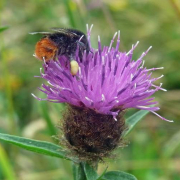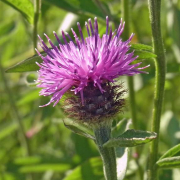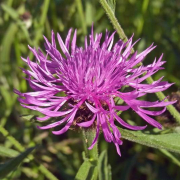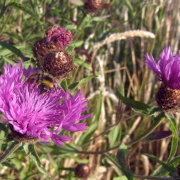Common knapweed Centaurea nigra
Table of Contents
Common knapweed or ‘black knapweed’ has thistle like flowers and is a common UK wildflower, frequently found in grassland and meadows. It’s a valuable source of nectar making it a big favourite with many pollinators, including bees, butterflies and hoverflies.

Plant family: Asteraceae
Aliases: Black knapweed, hardheads, knot weed
Flowering period: June – September
Flower colour: Pink
Preferred soil type: Well drained
Habitat: Grassland, roadside verges
Status: Common
General information
Common knapweed is a hairy, erect, perennial wildflower and a member of the daisy family, reaching up to 1 metre in height. It’s a tough, hardy plant and one of the most common wildflowers in the UK. The pink – purple flowers closely resemble a thistle, but knapweed is not covered in thorns and needles, making identification between the two simple.
In the past eligible young women would play a love-divination game. This involved plucking out the existing petals on the flower head, then the plucked knapweed flower would be placed in their blouse. When as-yet unopened florets began to appear it would indicate the man of her dreams was nearby.
Identification

Flowers: The flower heads are mostly solitary and relatively small and hard (hence the name ‘hardheads’) and produce pink – purple flowers. The ‘thistle like’ flowers emerge from the tight, hard buds giving the appearance of shaving brushes. Each flower produces many extended disc florets, all of a similar length, however in certain cases they will produce ray florets.
Leaves: The dull green, hairy leaves of common knapweed are alternate, oblong to lanceolate, unlobed or slightly lobed. The upper leaves are narrow and unlobed.
Value for wildlife
The rich source of pollen produced by this plant makes it a firm favourite all types of pollinators. It’s loved by bees, in fact it’s rare to walk past a cluster of knapweed and not see any bees. It’s very attractive of all kinds of butterflies, including common blues and meadow browns. It’s seed are a valuable food source for various birds.
Uses for greater knapweed
Traditionally knapweed was used as a styptic to prevent bleeding to flesh wounds and cuts. For more information on the medical properties of common knapweed click on the link. The knapweed flower heads are edible and can be added to salads.
Common knapweed images
Click to enlarge

This work is licensed under a Creative Commons Attribution 4.0 International License.
You are free to use, share and adapt any of the images on this page, under the condition we receive a followed backlink to our website https://diversegardens.co.uk as the image source.

















